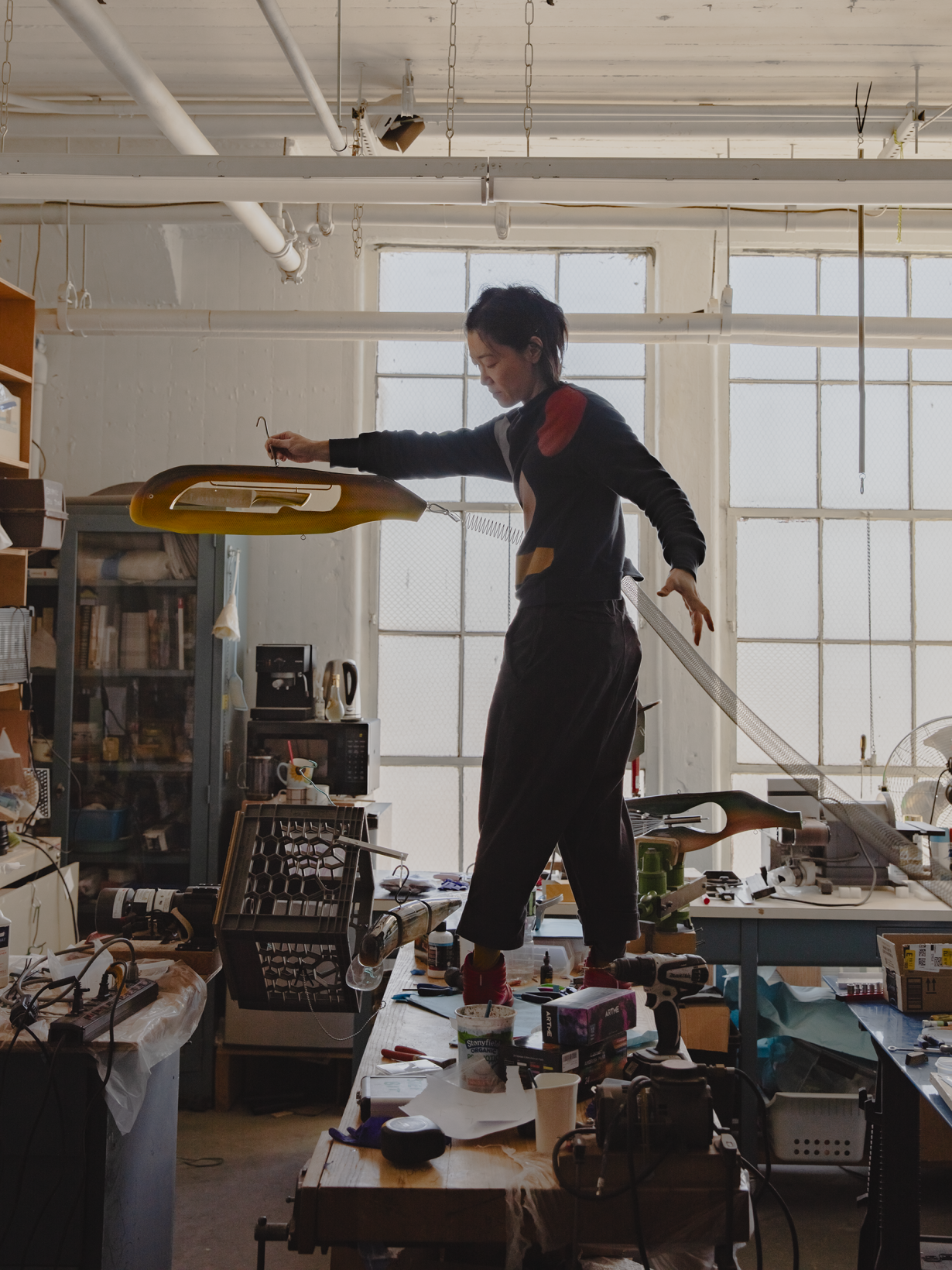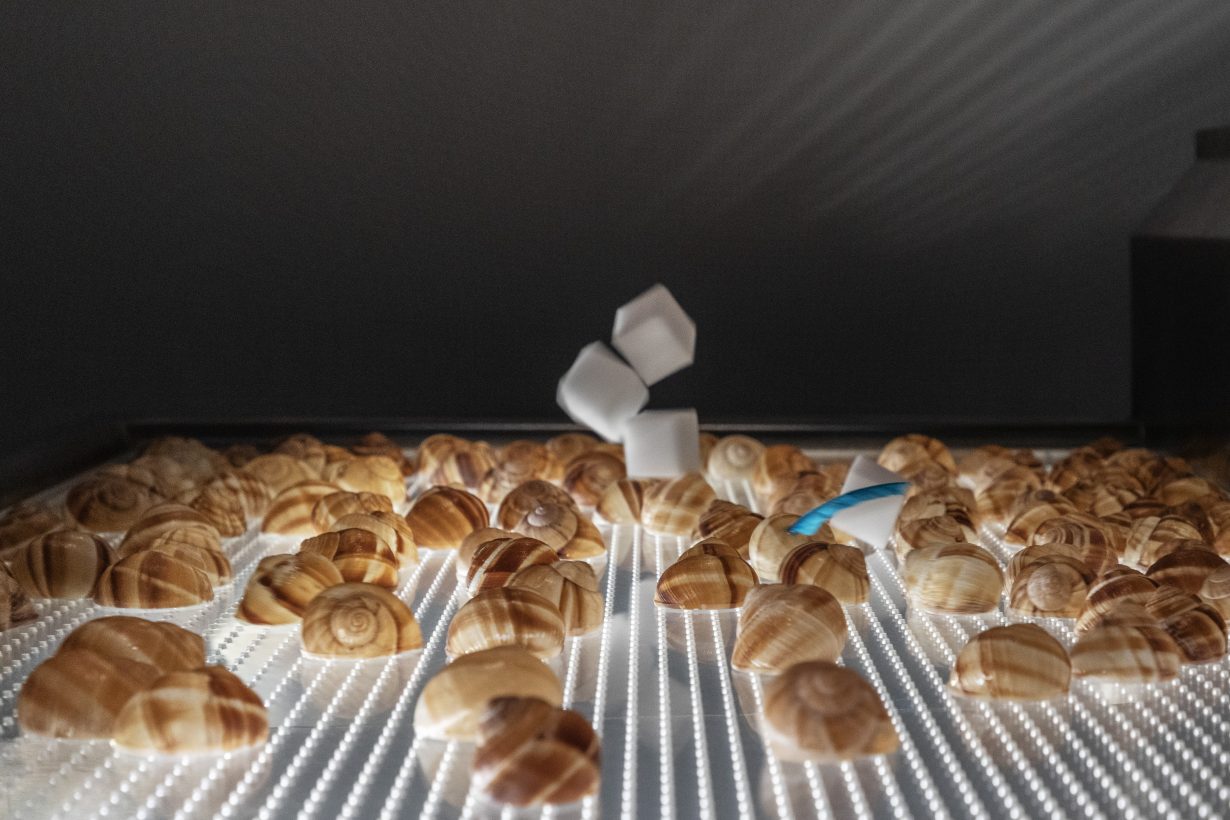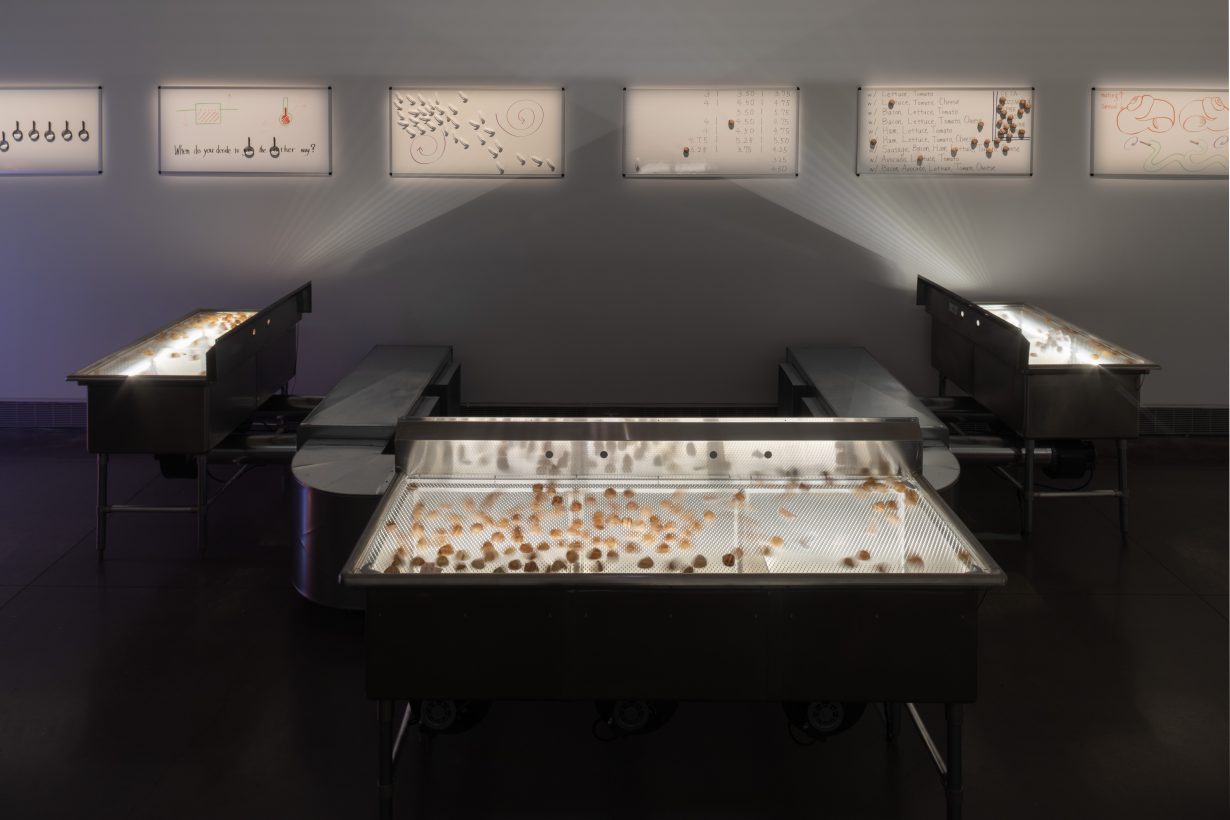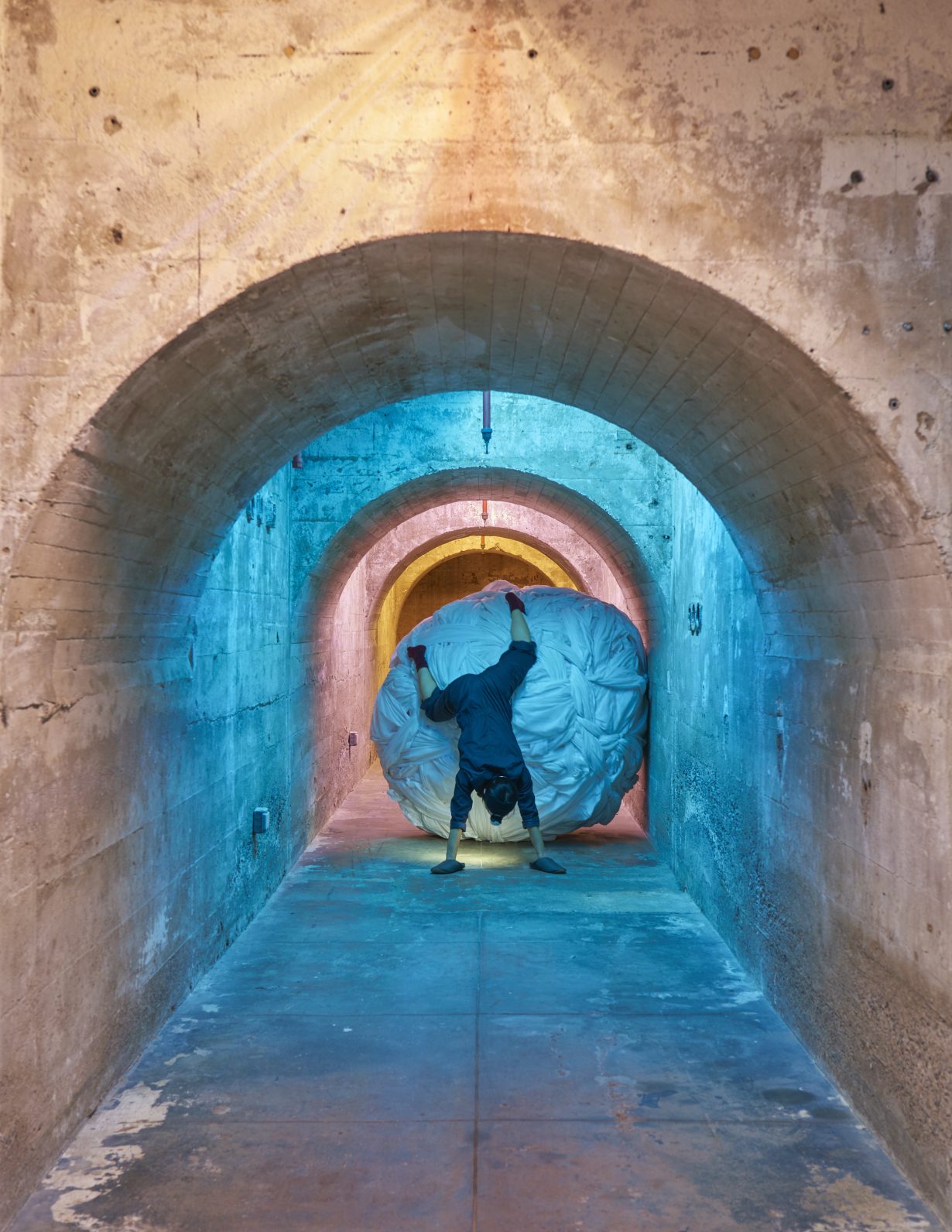The Japanese artist’s search for the eccentricities of life, in motherhood, bars, snails and dung beetles
“It’s a 4am story,” Aki Sasamoto laughs, which began with a problem: she wasn’t going to parties and desperately needed to dance. The solution came with an invitation to a drag show, or more specifically, a run-in with a bossy queen at a drag show, who told the Japanese artist that she looked miserable and hit her with a feather boa. “I was like, oh, I think I needed that.”
Sasamoto had been researching chirality: the asymmetries found throughout nature – for example, in the division of humans into righties and a smaller contingent of lefties. She asked an entomologist, a dream psychologist and other specialists about the phenomenon. A biologist told her there must be an evolutionary necessity for traits to persist over generations. It surprised him that certain minority traits hadn’t disappeared entirely given their irrelevance to the reproductive mission of life. The conversation turned into a fight, Sasamoto arguing that “we need the leftie, we need the eccentric”. She sensed that science alone couldn’t help with her question.

A trio of recent works – the installation Sink or Float (2022); the performance and installation Point Reflection (2023); and the video Point Reflection (Video) (2023) – explore chirality with reference to snail shells, which mainly spiral in a clockwise direction. Snails inhabiting anticlockwise homes both gain and lose from their variance: limited in viable mates yet resilient to predators accustomed to the rotation of the common shell. For Sink or Float, Sasamoto turns industrial kitchen sinks into the sculptural equivalent of air hockey tables: an HVAC system forces air through the perforated Plexiglas that covers the basins, setting various objects in motion. What results are dioramas of life in a crazy city, where clockwise shells, wall hooks, sugar packets and sponges jostle for space, have meet-cutes and zip on bottlecaps to the next party. On one perforated sheet, a turquoise feather distinguishes a shell, the trace of the drag queen’s boa enabling it to spin in the opposite direction from the rest. The bard with a feather in his cap, the misanthrope dancing with herself, anyone saying no to reproductive futurity or just too caught up in the beat to care: these are the eccentrics who join Sasamoto to fête and fight.


In the performance Point Reflection, set to live music by Alsarah and Matt Bauder, Sasamoto monologues in her characteristically deadpan style, blending elements of a confessional and a high-school lecture. The title, which describes the mirroring of a point across an axis, frames her chance encounter with an anticlockwise shell in a parking lot: “when things you thought were true can be flipped”, creating a new reality that “looks almost the same as before”. As with past works like Delicate Cycle (2016) and Yield Point (2017), the details of everyday life – however minute or circumstantial – offer insight into what science, mathematics and philosophy grapple with on various scales. Sasamoto’s childhood memory of bird shit hitting someone’s eyebrows, in the former work, is an opportunity to see from the bird’s and dung beetle’s perspectives. The attempt to extract every last bit of toothpaste makes her question the yield point of its tube and if she can go beyond that limit. The comedy and pleasure of these works extends to the installations, designed with aids for exploring the matter at hand: from the massive ball of bedsheets Sasamoto rolls as a dung beetle would (upside-down, with her feet) to the vertical and horizontal trampolines to test tensile strength. Any surface can become a whiteboard for the artist’s diagrams, which attempt to plot her topics while hinting at worlds outside their bounds. In Point Reflection, Sasamoto draws spirals in opposite directions on a cylindrical duct then overlays a bell curve. She talks about the onset of her midlife crisis, wondering if she might push past the “expected surprise”: the median, the normal response – aging in its clockwise state. “Why not?” she asks. “A switch for eccentricity is not available until you flip it.”

When I spoke with Sasamoto, she observed that many aspects of the built environment are designed for righties, including elementary school classrooms with windows on the left so right arms don’t cast shadows on the desks. It’s the lefties who write in darkness, and it’s in darkness that one learns to flip the switch.
Sasamoto’s ‘4am story’ is a bit of a red herring, as she’s chosen to trade the party circuit for “an in-house party” with her five-year-old son Ray. Still, her debt to the nightlife is evident throughout her work. Club dancing and free jazz continue to influence her mode of structured improvisation, in which the physical elements of her installations operate as spatial scores.
The bar is an enduring setting for the artist, foremost as a place to meet friends and strangers to hash out ideas, often inspiring the terms and diagrams of her pieces. Multiple works have merged this site with the gallery. In the performance Wrong Happy Hour (2014), Sasamoto plays barkeep, appearing from behind a moveable wall to stumble around in 90-degree glasses and clumsily make espressos, navigating the narrow space in a garbage can on wheels. As she reflects on her “sort of partner” and the demise of a former relationship, her feelings literally transform the space. The wall advances, shrinking the room and forcing the assembled audience out onto the street – leaving her with a watering hole for one. If romance entails making room for another, then on this night, selfishness wins out.

When a kidney condition and pregnancy came in quick succession during the late 2010s, Sasamoto had to pause her drinking and live vicariously through the red oak bars and hand-blown whiskey glasses that began populating her work. The physical changes she was undergoing became content for mock-forecast videos like Weather Bar Forecast #1 and Weather Bar Forecast #2 (both 2021), installed on TVs at standard sports-bar height. In the former, Sasamoto’s voiceover describes “the local weather inside your body” where “liquid will move against the dry front, against the oesophagus at a rate of 30 miles per hour”. The artist adds cocktail straws and herbs to an empty whiskey glass, puts that ‘drink’ inside a rounded vessel, and draws an HVAC duct close. Connected to a centrifugal fan, the duct blows a steady stream of air that causes the vessel’s contents to spin and clatter. Recalling Sasamoto’s diagrams and structured improvisation, the measured prognoses of the weather forecaster – even when accurate – capture neither the force nor strangeness of actual phenomena, whether on the scale of climate change, the intimate workings of the body, or an ingenious simulation thereof.
Sasamoto has likened pregnancy and motherhood in middle age to a “phase transition”, whereby a liquid, gas or solid can transform into another state. In a 2020 performance of the same name, she is hemmed in on one side by the needs, curiosity and scrutiny of younger generations, on the other by the guidance and hauntings of elders and ancestors. The hot wind of youth and the chill of the old risk coalescing into a tornado, taking “all the desire out of you”. Still, the artist will not consign herself to fatalism. In the performance Point Reflection, Sasamoto imagines a horizon of eccentricity “beyond the gentle diminishing of the bell curve”. Here, when the “solid desire” of youth has passed, there remains “an interesting state – supercritical fluid – of being at the same time liquid and gas”. With a bit of optimism and a nimble hand on her markers, Sasamoto can find her way through even the most constricting weather system or diagram. Living a supercritical life means believing in our capacity to continue to change.
Point Reflection is on show at the Queens Museum, New York, through 7 April. Her solo exhibition Sounding Lines is on show at Para Site, Hong Kong, 16 March – 28 July, with performances on 15 and 18 March
Tyler Coburn is an artist, writer and teacher based in New York
